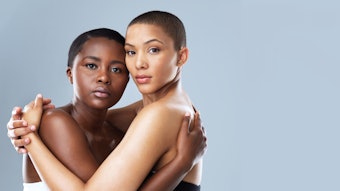
Inclusivity is a word we hear often, but what does it really mean? Inclusivity is a practice or action that works to ensure everyone, regardless of their background, identity or personal characteristics feels welcome, respected and valued.
When it comes to skin care and esthetics, offering inclusive skin care options really means creating a space where every client feels like they can walk into your spa and know that they will be valued, respected and catered to. It involves understanding and addressing the unique needs of a diverse clientele, which could range from different skin conditions and cultural backgrounds to age, personal preference and gender.
An inclusive spa menu goes beyond simply offering a wide variety of treatments. In fact, it’s probably logistically and financially impossible to add every single treatment you’ve come across to serve a diverse clientele. However, you can have an inclusive spa menu with just a few simple shifts in wording, seeking more knowledge surrounding different sensitivities and best practices, and actively working to address a wider range of skin conditions and concerns.
Language of Love
When you have an inclusive spa menu, essentially every client can find something that meets their specific needs. That doesn’t mean you have to significantly increase your treatment offerings, but it does mean adjusting the language in your service menu.
Consider offering a menu where you have different treatment lengths instead of specialized services. For instance, you could offer a 30-, 60- and 90-minute treatment time, and with each level, comes different customizable offerings based on the client’s skin needs at the time of their service.
This can be helpful to ensure clients feel like they are getting individualized treatments based on their unique skin conditions and needs, instead of a run of the mill acne or anti-aging facial, or worse, leaving them feeling excluded because the menu uses wording like “for her” or “for him” in the description.
In addition to gender neutral wording, you can also shift your language to include phrases like “for all skin types” instead of addressing normal/oily/dry skin specifically. Words like “customizable” and “personalized” are effective at making a client feel like their unique needs will be addressed, and it will enhance client satisfaction knowing they are getting something that is specific to their skin type and needs.
Finding balance in these efforts is important too, as you don’t want to go too broad and give the impression you have knowledge in areas you don’t. For instance, clients seeking care who are undergoing chemotherapy have specific needs that require comprehensive training on behalf of the esthetician. Oncology esthetics is a specialty area where practitioners need to have a thorough understanding of the effects of how cancer treatments change the skin and how to make modifications that won’t cause reactions or further sensitize the skin.
Cultural Sensitivities
Simply being aware of cultural sensitivities can go a long way when it comes to making guests feel included at your spa. Some cultures place a high value on modesty. Guests may not feel comfortable without accommodations that allow them to maintain modesty. You can help this client feel comfortable by having private changing areas and not requiring them to change into a spa wrap for a service. It is essential to be prepared and aware if a guest prefers to keep their clothing on, and how you’ll continue the service without making them feel uncomfortable.
Knowledge is Power
As any seasoned esthetician would tell you, age, sex, ethnicity and lifestyle all contribute to various skin types and tones. Understanding the intricate puzzle of how all these key factors play a role in the condition of the client’s skin is essential to your success as an esthetician and takes practice.
Knowing that what’s right for one client, may not be what’s right for another, is rule number one. Offering customized solution-oriented treatments can give you the latitude to give each client the results they want, even if they don’t get there the same way.
While you may market your services “for all skin types,” you must understand that darker skin types can often see hypopigmentation and keloid scarring with more aggressive treatments like deeper chemical peels, lasers and other modalities. It’s important to seek adequate training for treating darker skin, so you can properly address their needs in a safe and inclusive way.
The Benefits of Being Inclusive
An inclusive spa menu can open doors to new client segments who wouldn’t normally seek out your services. When your treatment offerings encompass a range of skin types, conditions and preferences, you can attract a broader clientele, and consequently, increase your revenue.
The benefit of creating an inclusive spa environment goes beyond financial gains. It helps foster a sense of community and belonging that makes people feel included and valued.
Marketing an Inclusive Spa Menu
Ensure your marketing materials embrace a variety of models and clients. This includes your website, promotional pieces in print and your social media. Representation matters to your clients, and seeing diversity in your marketing will help attract a broader client base.
3 Easy Inclusivity Tips
- Staff Training: Provide ongoing training for staff on inclusivity and cultural awareness. This can include workshops, seminars and online courses, where you can lean on experts in the field.
- Client Feedback: Continuously seek feedback from clients about their experiences and use this information to make improvements.
- Industry Trends: Stay informed about trends and best practices in inclusivity within the wellness industry. Attend conferences, read industry publications and network with other spa professionals to keep your knowledge current.
Continuous Improvement
Inclusivity is an ongoing process and should be reviewed regularly. Make sure you have up-to-date policies on inclusivity, and continuously take the time to reflect whether your treatment options and marketing strategies foster growing a diverse clientele.
As a third-generation CEO of Circadia by Dr. Pugliese, Michael Q. Pugliese has continued the family legacy of providing exceptional skincare solutions to clients worldwide. Michael's expertise as a sought-after educator and writer has enabled him to teach the principles of modern skin science to industry professionals across the globe. Under Michael's leadership, Circadia has achieved global recognition and distribution, making it possible for individuals with different skin types from all corners of the world to access quality skincare products.










